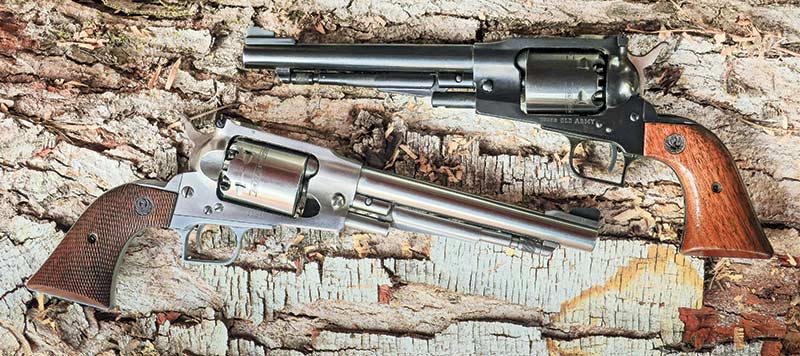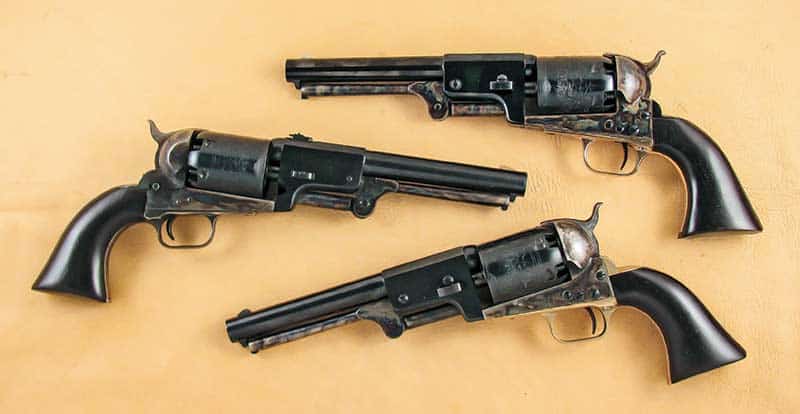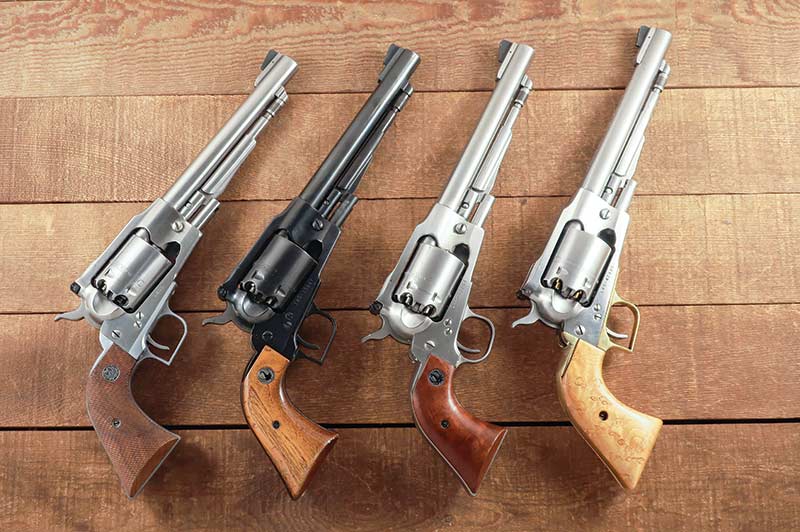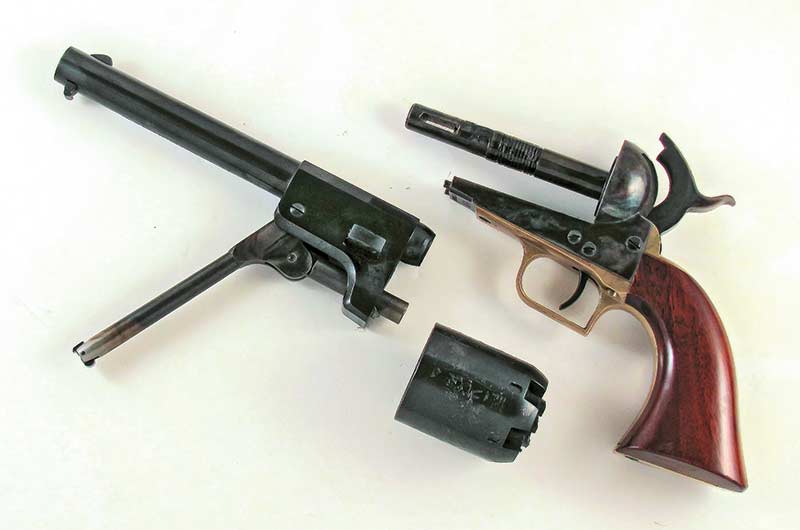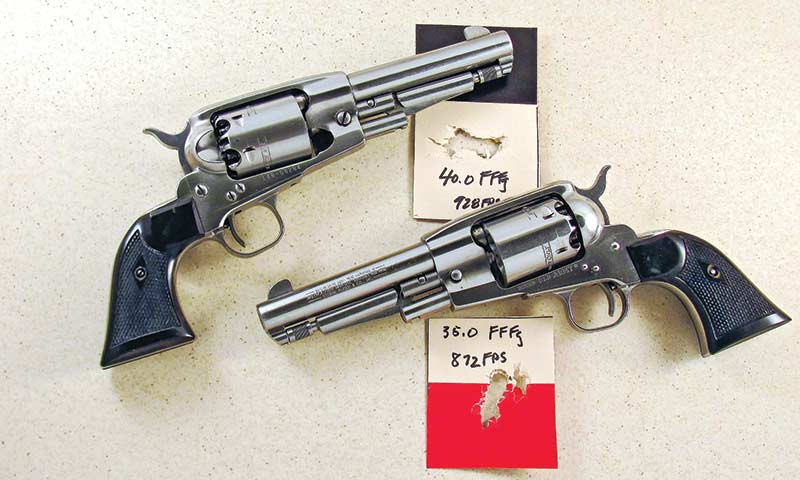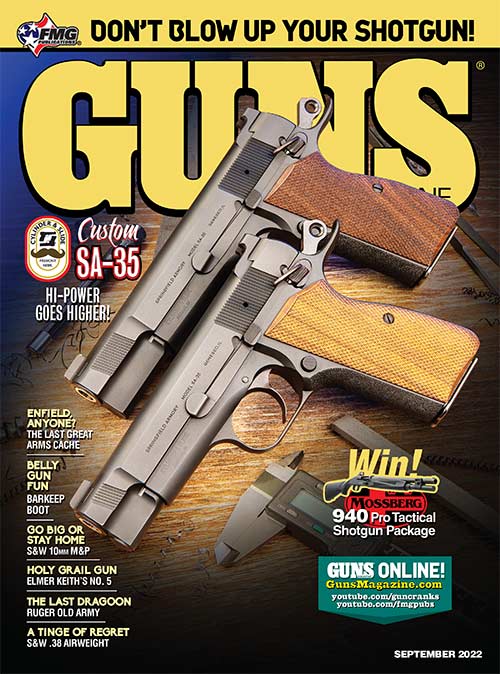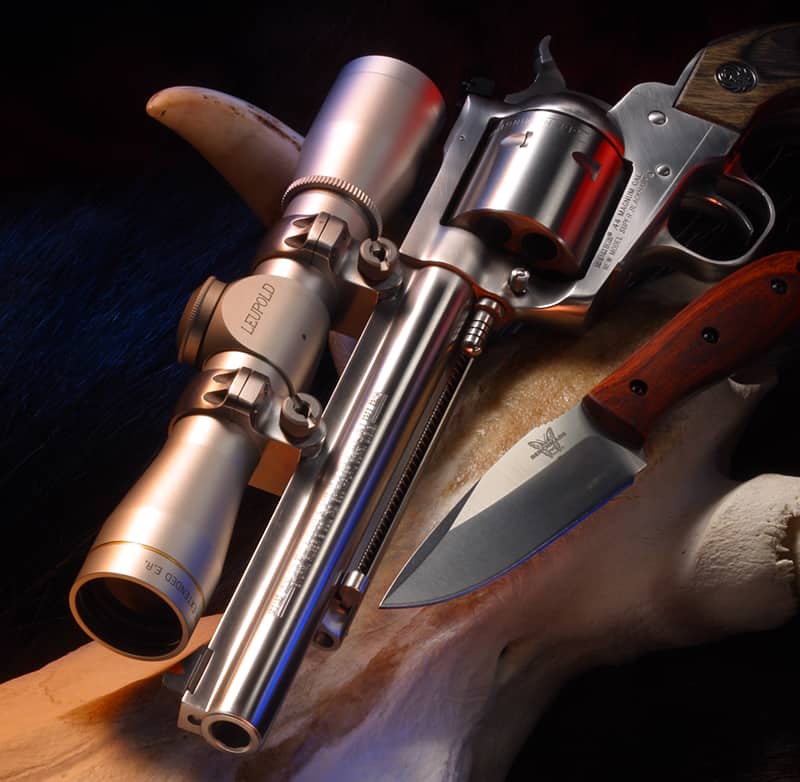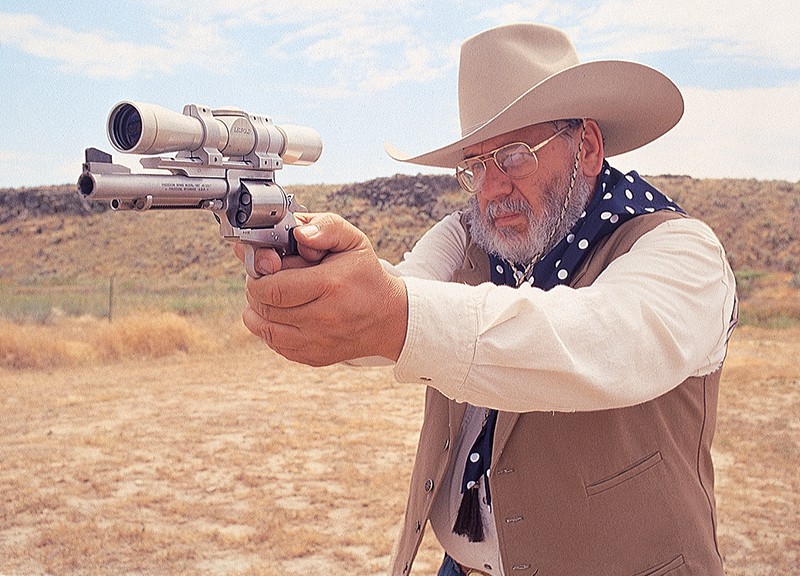Ruger Old Army
The Last Dragoon
Colt had produced five Dragoon Models from 1847 to the early 1850s, consisting of the original Walker, the Whitneyville Walker Dragoon/Transition Model, and then the 1st, 2nd and 3rd Model Dragoons. All of these used 0.45″ round balls, and being percussion pistols, were loaded from the front of the cylinder with powder and ball. Percussion caps were then placed on the nipples at the back of the cylinder.
The first four models all had the square-backed trigger guard Bill Ruger later used on his Super Blackhawk. However, the 3rd Model Dragoon switched to the round trigger guard. The original Colt 1851 Navy also had a square-back trigger guard. However, the grip frame was the size and shape that would ultimately be found on the Colt Single Action. So, for the Super Blackhawk, Bill Ruger basically used a grip frame that Colt had dropped more than 100 years earlier.
Cap And Ball Redux
By the 1970s, black powder shooting had become a renaissance of sorts and Bill Ruger did not miss this. The replica percussion pistols of the time were not always of the best quality and strength so Ruger set out to produce a high quality cap-and-ball sixgun. The result was the Ruger Old Army that carried on where the Colt Dragoons left off. However, at least in my mind, Bill made two mistakes. I am one of those who found very little help with the Super Blackhawk Grip frame with the square-backed trigger guard pounding the knuckle of the middle finger of my shooting hand with every shot. The same grip frame on the much milder shooting Colt Dragoon suited me just fine. I am of the opinion Bill Ruger should have equipped his original Old Army with the Dragoon/Super Blackhawk grip frame and he should also have called it the Ruger Old Army Dragoon.
The Super Blackhawk grip frame in brass was offered as an option on the Ruger Old Army and my most-used Old Army — which is a true match-winning pistol — has been so equipped. Ruger wisely fitted his Old Army with excellent adjustable sights offering both blue and stainless steel versions. Two of my other Ruger Old Army sixguns, one blue and one stainless steel, have been equipped with Super Blackhawk grip frames. One blued and one stainless-steel-style nickel-plated, for my hand they work just fine.
With the arrival of the great popularity of Cowboy Action Shooting, Ruger furnished fixed-sighted models of the Old Army with 7-½” versions in both blue and stainless as well as 5-½” stainless steel sixguns. I used a pair of the latter in competition for Cowboy Action Shooting, while I used the Dragoon-gripped longer-barreled adjustable-sighted models for competing in black powder matches.
Ruger’s Old Army was a completely modernized version of the old-style cap-and-ball sixguns in several ways. The chamber of the old Army is tapered to provide a very tight seal and help prevent a double discharge but it is still a good idea to use a wad or top off each chamber with a black powder lube. I make my own with beeswax mixed with mutton tallow. This not only helps prevent a second chamber from igniting but perhaps even more importantly, helps to keep the bore clean. The Ruger Old Army takes a larger diameter bullet than the standard 0.451″ or 0.454″ size of Colt or Remington be they original or replica, working best with a 0.457″ round ball or conical bullet.
The conical bullets give excellent accuracy in my 7-½” Old Army. Using a 225-grain conical over 35 grains by volume of Pyrodex P results in a muzzle velocity of 870 fps with six shots in 1″ at 25 yards. Energy-wise, this makes the Old Army the equivalent of .45 ACP Hardball. This accuracy, of course, is aided by the excellent adjustable sights on the Old Army. Using 40 grains of Pyrodex P or Triple-7 FFFg resulted in muzzle velocities are well over 1,000 fps with a 0.457″ round ball with excellent accuracy. Now we have surpassed .45 ACP Hardball and are in the +P range using a percussion sixgun with black powder.
Falling Down
One of the problems with both original and replica percussion pistols, especially the Walker and some of the Dragoons, was the propensity for the loading lever to unlatch and fall down when the sixgun was fired. My original Remington replica did this quite often. With the Old Army, the loading lever is positively locked into place and will not drop down upon firing. The loading lever, rammer and cylinder base pin are an inter-related assembly that can be removed from the sixgun with a simple turn of the large screw in the front of the frame. This is easily accomplished by using a coin as a screwdriver. This loading lever exerts the best leverage in seating the ball over the powder of any percussion revolver ever produced.
The Old Army was built on the Old Model action and until production ceased, they remained the only Ruger single-action with a traditional half cock and no transfer bar safety. This is one traditional-action sixgun that can be carried safely with six rounds as there are safety recesses in between each chamber for resting the hammer. They should always be used unless the hammer is resting upon an empty chamber.
Stainless steel nipples are set deeply into the cylinder to help prevent fragments of fired caps falling in the mechanism or behind the cylinder, thus causing a jam. This has never occurred with any Old Army revolver I have used. The Old Army is also the only percussion revolver that can be dry-fired as the hammer nose is designed to clear the nipples by 0.005″.
A few years back I started having misfires with my original Ruger Old Army. I replaced the factory nipples with custom bronze nipples and now all of my other Ruger Old Army sixguns have been fitted with stainless steel SliX-Shot nipples from SliX-Springs.
The original Old Army from the early 1970s was offered in both blue and stainless with adjustable sights. Production ceased in 2008. At the time, prime examples could be easily found for around $300–$350. Expect to pay triple that today. The last Old Army offered before they were dropped from production were both blued and stainless-steel fixed-sighted 5-½” barreled easy packin’ sixguns. Most cartridge shooters seem to prefer shorter barrels as witness Ruger’s great selling Vaquero is about 97% short barrels and only 3% is in 7-½” lengths.
Until the arrival of the 5-½” Old Army, most cap-and-ball shooters had been restricted to the longer barrels on factory guns, or they had to have them custom cut to shorter lengths. The Old Army makes a most-attractive shorter barrel sixgun. The Old Army short barrel was a good starting point and now both the Remington New Model Army and the Colt Models 1851, 1860 and 1861 are all available with shorter barrels.
Getting Dirty
When shooting black powder, especially if each chamber is topped off with a black powder lubricant, things tend to get a little messy and greasy. This is part of the fun, however, with smooth grips being matched up with black powder-fouled grease, things not only get a little messy, they also become a mite slippery. This is where it is nice to have checkered grips and even the Eagle Gunfighter Grips little shelf at the top of each grip panel that gives us something to hold on to. There is not much recoil, relatively speaking, with a percussion sixgun such as the Old Army. However, there is enough to make the gun slip in the hand. The checkering on the grips helps to prevent this from happening.
These Old Armies perform well with Speer’s 0.457″ round ball, Thompson’s Lubed Wad and CCI’s #11 percussion cap. My normally used three powders are used in both 35.0 and 40.0 — by volume — charges. Those powders are Goex FFFg black powder, Hodgdon’s Triple-7 FFFg and Pyrodex P. Charges are measured with a Thompson/Center powder measure. With 35.0 grains by volume of Triple-7 FFFg, muzzle velocity is 925 fps with six shots in 1-⅜” at 20 yards. Moving up to 40.0 grains of Triple-7 FFFg yields 1,130 fps and a group of 1-¾”. These velocities are right at, or even exceed, the same obtained with the longer barreled Old Army. These loads are not necessarily recommended for Italian replicas of Colt or Remington percussion revolvers.
Some sixgunners do use the Old Army for hunting and this can be done within reason. If a standard .45 Colt load or a +P .45 ACP load would be appropriate for whatever is being hunted, then the Old Army is also appropriate.

Get More Revolver Content Every Week!
Sign up for the Wheelgun Wednesday newsletter here:
